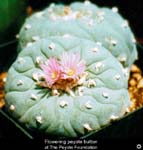
Visionary Cactus Guide

Lophophora
The name of this genus is derived from the Greek words "lophos" for crest and "phoreo" for bearer or carrier. The most widely known and utilized Genus of the many Visionary cacti. This Genus was once known as Anhalonium, but is no longer recognised.
L. diffusa -
A sacred plant held in high esteem by many Mexican Indians. A rare and very slow growing solitary cactus that is limited to a small range in the wild, now sadly threatened. A two year old specimen can be only 2 cm across. This cactus is soft, yellow green in color, having indefinite ribs and a 15 cm long conical, carrot like root. It is very similar in appearance to its more famous relative. Known to bloom in its 3rd year, with whitish yellow flowers.
Being spineless it appears to defend itself by being very unobtrusive and barely sticking out of the ground, and by its extremely bitter taste. Contains only traces of mescaline. Produces a dream-like delirium with realistic hallucinations similar to Datura alkaloids due to its high content of (tetrahydro) isoquinolines. This plant appears to be an earlier evolutionary form of L. williamsii.
Contains: anhalinine, anhalonidine, hordenine, isopellotine, mescaline, N-methylmescaline, O-methylpellotine, pellotine.
L. echinata -
Contains: mescaline.
L. fricii -
Contains: mescaline, pellotine.
L. jourdaniana -
Contains: mescaline, pellotine.
L. lutea -
Very similar to L. williamsii except having sparcely tuberculate ribs divided by winding grooves. Pale yellow flowers and a yellowish down. Native to Mexico and widely and sparsely distributed. Can also be classified as Lophophora ziegleri.
Takes full sun and will not tolerate a frost. Very slow growing, does best as a graft.
Reported to contain unspecified alkaloids.
L. williamsii -
(Peyote) First described in 1560, Peyote is by far the best known and most widely utilized of the psychoactive cacti. Named after the Nahuatl (Aztec language) word for " cocoon silk " because of its wooly center tuft. A spineless, tufted, bluish-green, button shaped cactus with a large conical root. Native to the arid areas of central Mexico to northern Texas. The succulent crowns measure to 8 cm in diameter and are divided into 5 -14 rounded, vertical, more or less distinct ribs. Each tubercle has flat, small areolas with tufts of hair. Younger plants start with only 4 ribs, while old plants have up to 14. Peyote are one of the few Cacti to have spines only when they are seedlings.
There are several different cultivars of L. williamsii including caespitosa, decipiens, pentagona and texana. This cactus was classified as an endangered species by the Mexican government in 1991.
Plants bloom with one or more pinkish white, funnel shaped flowers, growing from the top, and surrounded by long hairs. Fruit is red and club shaped, with small black seeds.
Some tribes including the Huichol recognize two distinct forms. The Catus called Tzinouritehua-hikuri ( Peyote of the God ) is the larger, very bitter and of course more potent form. The Rhaitoumuanitari-hikuri ( Peyote of the Goddess ) form is said to be smaller and more palatable. It is now believed however that it is the same species but at different ages.
Peyote is one of the slowest growing plants in existence, taking 13 years or more to mature. Older cacti are generally much higher in alkaloids than young plants. The very oldest plants are worshiped by the Indians as "Father or Grandfather Peyote". They are often kept as amulets or placed on a crescent alter to be revered as a sacred object. A baseball sized Cactus can be well over 30 years old.
There have been over sixty alkaloids discovered in this plant which has been described as a " little green chemical factory ". This Cactus is known to contain 56 nitrogen containing compounds derived from a tyrosine base, as well as 20 tyramine-like alkaloids. Mescaline content usually ranges from about 3 - 6%, by dry weight, averaging around 4%, but is highly variable. Most of the alkaloids present can be classified as B-phenethylamines like mescaline or tetrahydroisoquinolines like hordenine. These chemicals differ in structure from LSD in that they don't have a complete indole ring. Mescaline content of fresh, undried cactus is reported at 0.4 %.
Propagate by seed or shoots. These cacti will tolerate some cold if kept perfectly dry, but not frost.
Contains: N-acetyl-3-methoxy-4,5-dimethoxyphenethylamine, alanine, anhalamine, anhalidine, anhalinine, anhalonidine (14% of the total alkaloids), anhalonine, anhalotine, 3,4-dihydroxy-5-methoxyphenethylamine, epinine, dopamine, 3,4-dimethoxyphenethylamine, N-acetylanhalamine, N-acetylanhalonine, N-formylanhalamine, N-formylanhalinine, N-formylanhalonidine, N-formylanhalonine, N-formyl-O-methylanhalonidine, N-formyl-3-methoxy-4,5-dimethoxyphenethylamine, glycine (8% of the total alkaloids), hordenine, 3-hydroxy-4,5-dimethoxyphenethylamine (1 to 5% of the total alkaloids), isoanhalamine, isoanhalonidine, 3-hydroxy-4,5-dimethoxy-N-methylphenethylamine, isoanhalidine, isopellotine, lophophorine (5% of the total alkaloids), 3-hydroxy-4,5-dimethoxy-N,N-dimethoxyphenethylamine, lophorine, lophotine iodide, mescaline (30% of the total alkaloids), mescaline citrimide, mescaline malaimide, mescaline maleimide, mescaline succinimide, isocitrimide lactone mescaline , N-acetylmescaline, N-formylmescaline, N-methylmescaline, mescalotam, 3-methoxytyramine, 3-methoxy-N-methyltyramine, 3-methoxy-N,N-dimethyltyramine, O-methylanhalonidine, O-methylpeyoxylic acid, O-methylpeyoruvic acid, N-methyltyramine, pellotine (17% of the total alkaloids), peyoglunal, peyoglutam, peyonine, peyophorine, peyouvic acid, peyotine iodide, peyoxylic acid, tyramine.

